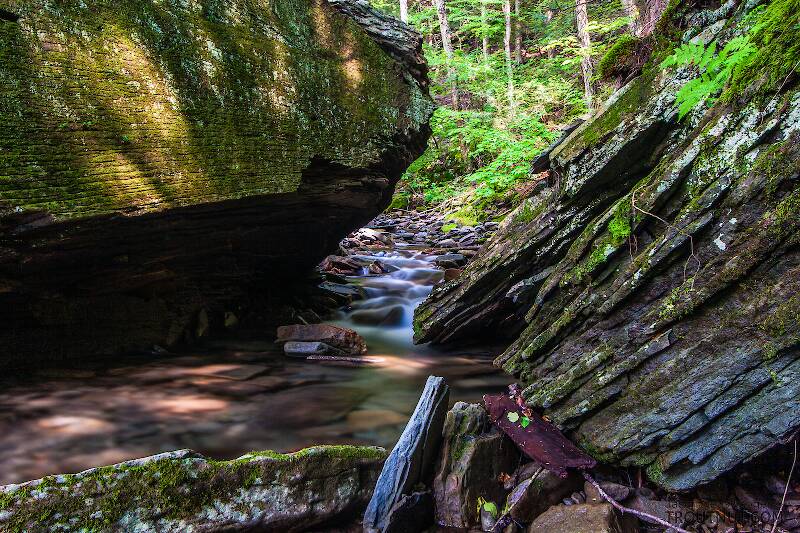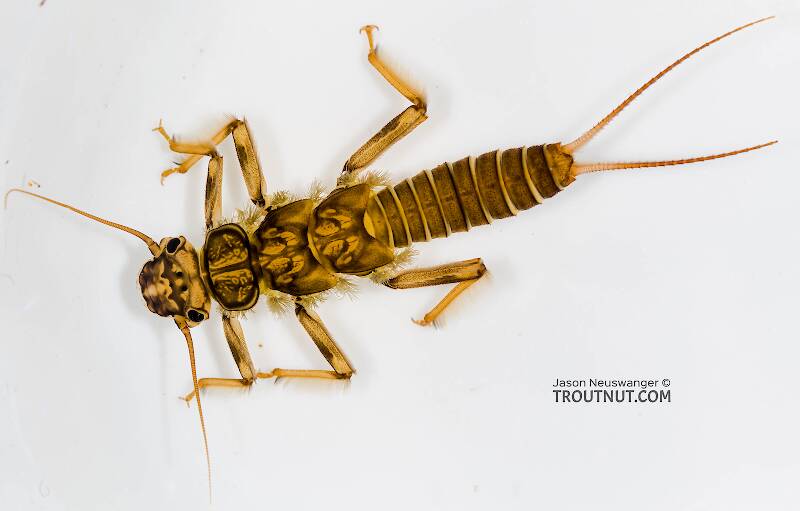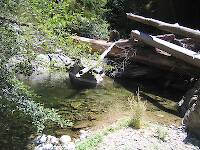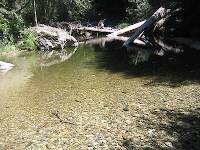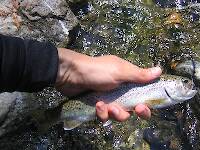
Blue-winged Olives
Baetis
Tiny Baetis mayflies are perhaps the most commonly encountered and imitated by anglers on all American trout streams due to their great abundance, widespread distribution, and trout-friendly emergence habits.
Featured on the forum

Troutnut is a project started in 2003 by salmonid ecologist Jason "Troutnut" Neuswanger to help anglers and
fly tyers unabashedly embrace the entomological side of the sport. Learn more about Troutnut or
support the project for an enhanced experience here.
Greglindsey on Jan 11, 2014January 11th, 2014, 10:16 am EST
When I usually nymph I use a fifteen foot leader made out of Maximum then tipped off with tippet. When I do see a fish rise I find that it is tough to fish a dry fly with that leader. I don't know if it would be hard long line nymphing a shorter leader or not. If anyone has any tips please share.
Thanks
Thanks
Crepuscular on Jan 12, 2014January 12th, 2014, 7:04 am EST
Hi Greg. 15' seems pretty long of a leader for nymphing to me, unless you are using a bobber. A 12-15 foot dry fly leader is about standard. So what is it that you are finding difficult about fishing the dry fly with that leader? Are you getting drag? If that's the case it all depends on the exact current situation and presentation of the fly. Sometimes it s as easy as just changing your position in relation to your target. If you are set on always using a long line nymphing technique a la George Daniels (but even he says he prefers to tight line nymph) it may just be your presentation. If you are having trouble turning the leader over, it may be your leader construction. So I may be able to give a better answer if you elaborate on what you mean when you say you find it tough to fish a dry fly with that leader.
Eric
Eric
Greglindsey on Jan 12, 2014January 12th, 2014, 8:14 am EST
Well it has a lot of drag and when I cast the leader seems heavy. I'm fishing the leader with a 10ft 3wt. I don't know if it is the leader material or what. I just want a leader that I can effectively fish nymphs and dries on.
Stokes on Jan 12, 2014January 12th, 2014, 8:26 am EST
I'm new at stream fishing,so this is just what I would try,dont know that it is correct or not.I would find some medium between what you use for dries and what you are now using
Wbranch on Jan 12, 2014January 12th, 2014, 10:40 am EST
Firstly I'm having a bit of a problem trying to understand how you can effectively nymph very much of anything larger than a #14 nymph and maybe one "B" size shot, or weighted fly, on a 10' #3 rod/line combo. I've thrown my share of nymphs over the years with very good success and I'd never use any rod less than a 8' 6" #5 for day in and day out nymphing using flies from a #16 to a #8. Now of course if all I was fishing was a clear spring creek where sleath and presentation were key then I would use the 10' #3. But I'd figure my fly sizes would be #16 - #22.
For the nymphing I most often do I use a 9' - 10' leader tipped out to 3x or 4x. With such a rig I can fish with, or without, an indicator. You can easily throw a couple BB size shot, and use flies from a #16 to a #8. You can still high stick with this method and to be frank it is much easier to keep your line off of the water with a 9' - 10' leader than one that is 15' long.
For the nymphing I most often do I use a 9' - 10' leader tipped out to 3x or 4x. With such a rig I can fish with, or without, an indicator. You can easily throw a couple BB size shot, and use flies from a #16 to a #8. You can still high stick with this method and to be frank it is much easier to keep your line off of the water with a 9' - 10' leader than one that is 15' long.
Catskill fly fisher for fifty-five years.
Martinlf on Jan 12, 2014January 12th, 2014, 1:36 pm EST
With long rods designed for European nymphing George Daniels recommends a 9'0X knotless leader with a sighter then 4-5 foot tippet as a good compromise leader for both nymphing and dry fly fishing. That gives you about 13' of leader on the short side for nymphs or dries, and you can always cut the tippet back. But so much depends on your casting style, position in relation to the fish, dry fly strategy, nymphing approach, etc., as Eric notes. And if you aren't throwing big flies a 9' 3X or 2X might possibly work very well. Daniels typically fishes weighted nymphs, avoiding split shot, though he notes he will use it on occasion. You might take a look at his book, Dynamic Nymphing, for some ideas; he has other leaders in it, and the book gives an idea about how much variation exists in terms of what others do.
"He spread them a yard and a half. 'And every one that got away is this big.'"
--Fred Chappell
--Fred Chappell
PaulRoberts on Jan 12, 2014January 12th, 2014, 2:42 pm EST
Sounds like maybe you are trying to fish "all-round" with a specialized long-line nymphing rig. Especially long leaders have their place, but they can be unwieldy for a lot of applications.
A standard leader configuration can be used for a lot of dry and wet uses. It's the roughly 60/20/20 configuration: 60% butt, 20% transition, 20% tippet. That should get you started on the right path and will cover a lot of water.
Make sure your butt is appropriate in mass for the fly line too. For a 3 wt I start at .015 to .016 diameter. That offers plenty of mass to start turn a standard leader and fly over, without overwhelming a 3wt.
There are ways of setting up a line to change out entire leaders, usually via loops. Or, if you have enough of them, you can dedicate reels (or spools) for specific uses.
A standard leader configuration can be used for a lot of dry and wet uses. It's the roughly 60/20/20 configuration: 60% butt, 20% transition, 20% tippet. That should get you started on the right path and will cover a lot of water.
Make sure your butt is appropriate in mass for the fly line too. For a 3 wt I start at .015 to .016 diameter. That offers plenty of mass to start turn a standard leader and fly over, without overwhelming a 3wt.
There are ways of setting up a line to change out entire leaders, usually via loops. Or, if you have enough of them, you can dedicate reels (or spools) for specific uses.
Crepuscular on Jan 12, 2014January 12th, 2014, 2:44 pm EST
Greg can you elaborate on your Maxima leader construction?
EDIT
Well I guess I missed Paul's post when I wrote mine. So there you have it. He pretty well sums it up with some excellent advice on leader construction.
EDIT
Well I guess I missed Paul's post when I wrote mine. So there you have it. He pretty well sums it up with some excellent advice on leader construction.
Greglindsey on Jan 13, 2014January 13th, 2014, 2:50 pm EST
Ok thanks for the information guys I guess I will need too do some leader reconstruction. I will look in the book and see what I can find.
Wbranch on Jan 14, 2014January 14th, 2014, 4:11 pm EST
So what's wrong with a nice store bought 9' - 12' tapered leader? Why have a relative newcomer go out and spend $60 - $100 for a kit to make hand knotted leaders? I remember back in my 20's I bought an Orvis leader tying kit. I used it for a couple of seasons and got bored with it and have not tied a complete trout leader in at least twenty-five years. Each to his own but to me there is nothing like a modern nylon 9' - 12' knotless leader with a nice heavy butt and just one blood knot (or micro ring) to attach a piece of 24" - 36" long fluorocarbon tippet.
Catskill fly fisher for fifty-five years.
Stokes on Jan 14, 2014January 14th, 2014, 5:09 pm EST
I like the knotless braided leaders,just tie a loop in a couple feet of tippet material.I have the leaders in 5 1/2 ft,7 1/2,9 1/2 and 12 ft lengths.Someone gave me a 16 footer that I havent found a use for,might use it for a "grass leader".
PaulRoberts on Jan 15, 2014January 15th, 2014, 1:41 pm EST
I admit I have little experience with knotless leaders. I've used them here and there, but mostly only the butt taper from them, modifying from there. At the first FF camp I ran I bought tapered leaders to save time, and ... my! The butts were too heavy and the tapers too short! I had to stop the class and do a leader construction lesson. Obviously I had the wrong leaders to begin with. I know there are plenty of good leaders out there and that most FFer's use them.
I guess I started tying leaders long ago and never left it. It's plenty easy. No "special formula" materials are needed except that abrasion resistant lines are most durable. I used Trilene XT (and now Trilene Sensation) for years. A 300yd spool costs 5-7dollars and lasts a looong time, esp the larger diameters. I even use it for tippet material down to .006. Never could understand paying almost the same amount for 30meters -especially for transition and tippet diameters. which I use the most of. For fine tippets, .007 and under, I buy tippet spools though.
Just my 2cents and offered just to chat fishing. No strong opinions on the subject.
I guess I started tying leaders long ago and never left it. It's plenty easy. No "special formula" materials are needed except that abrasion resistant lines are most durable. I used Trilene XT (and now Trilene Sensation) for years. A 300yd spool costs 5-7dollars and lasts a looong time, esp the larger diameters. I even use it for tippet material down to .006. Never could understand paying almost the same amount for 30meters -especially for transition and tippet diameters. which I use the most of. For fine tippets, .007 and under, I buy tippet spools though.
Just my 2cents and offered just to chat fishing. No strong opinions on the subject.
Wbranch on Jan 16, 2014January 16th, 2014, 12:51 am EST
One of the reasons why I primarily use knotless leaders is that one of the rivers that I fish most often has large amounts of aquatic vegetation especially from June forward. The vegetation is constantly floating down river in the water column and the multiple knots on a knotted leader act like little magnets for the bits of grass.
I am on the river to cast and catch trout and not to be constantly wasting time picking bits of green gunk off of my leader. Additionally since I have rarely used knotted leaders and learned to cast with knotless leaders I have worked through any limitations they have to compared to the potential efficiency I would gain with knotted leaders.
I am on the river to cast and catch trout and not to be constantly wasting time picking bits of green gunk off of my leader. Additionally since I have rarely used knotted leaders and learned to cast with knotless leaders I have worked through any limitations they have to compared to the potential efficiency I would gain with knotted leaders.
Catskill fly fisher for fifty-five years.
Crepuscular on Jan 16, 2014January 16th, 2014, 3:27 am EST
Like Matt I like the tapered leaders for the absence of weed collecting knots. But I also go through a lot of leaders and it is just easier with the tapered leaders with tippet sections added on. That way I have one or maybe two knots and that's it. For years I tied my own leaders and just out of resistance to change put off buying the manufactured tapered leaders but now, with only a couple of exceptions the manufactured tapered leaders are the way to go for me. my $0.02
Feathers5
Posts: 287
Posts: 287
Feathers5 on Jan 16, 2014January 16th, 2014, 4:49 am EST
I tie my own nymph leaders, but carry some knotless leaders in case I start picking up a lot of weeds.
BoulderWork
Posts: 29
Posts: 29
BoulderWork on Jan 16, 2014January 16th, 2014, 7:41 am EST
There are many schools of thought on leader design, manufacture material sourcing and application of the design to particular types of fisheries and resident population.
Similar to Wbranch, I have purchased multiple leader tie kits from ORVIS and Maxima. In progression, I utilized ORVIS design recipes, reviewed and incorporated Humphrey/Harvey design into my working set of leaders, and now working through analyzing George Daniel's designs for application as well.
What is right about purchasing a leader tie kit is that sets a foundation for beginners and more advanced fly fisherman to gain a deeper understanding and appreciation of functioning versus non-functioning designs. How else can a budding novice learn?
Otherwise, I am a big fan of furled leaders for many reasons including the minimal use of knots, strength, design flexibility, and durability.
Similar to Wbranch, I have purchased multiple leader tie kits from ORVIS and Maxima. In progression, I utilized ORVIS design recipes, reviewed and incorporated Humphrey/Harvey design into my working set of leaders, and now working through analyzing George Daniel's designs for application as well.
What is right about purchasing a leader tie kit is that sets a foundation for beginners and more advanced fly fisherman to gain a deeper understanding and appreciation of functioning versus non-functioning designs. How else can a budding novice learn?
Otherwise, I am a big fan of furled leaders for many reasons including the minimal use of knots, strength, design flexibility, and durability.
Lastchance on Jan 16, 2014January 16th, 2014, 1:37 pm EST
To take it to the base level you actually don't even need a tapered leader to high stick nymph. I've already used a 6 ft. piece of the same size tippet tied to the butt end of my leader. A lot of nymphing, especially in pocket water, doesn't require casting. Sacrilegious I know. I know, I'm crazy, I don't know what I'm talking about, I don't read enough, etc. etc. Try to eliminate a belly in your leader, focus, and feel what's going on with the fly. Now, if you're on a large river and need to cast, or even a small stream and need to cast, this won't cut it for you. You need a leader that will turn over.
Quick Reply
Related Discussions
Topic
Replies
Last Reply

